Bel Fuse: How Bidirectional EV Charging Maximizes Battery Utility
More electric vehicles (EVs) are being driven towards net zero goals, each with a rechargeable battery. EVs not only reduce carbon emissions but also serve as potential energy sources if capable of bi-directional charging.
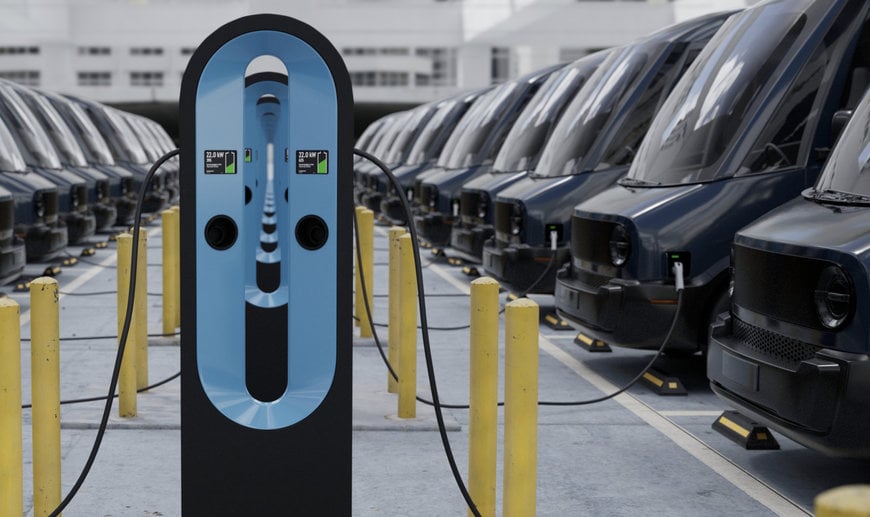
When power can move both ways, an EV becomes more than just four wheels that move people around. It’s an energy source in a smart grid that can help with demand shifting, power a residence during an outage, or act as a mobile charging unit for a commercial fleet.
Bi-directional charging is still in its infancy, but the technology is available to equip both the charging stations and the EVs themselves to support smarter power distribution in cities as well as enable a variety of industrial charging applications in agriculture, construction, and logistics.
More EVs means more batteries
EVs are accounting for more and more of the vehicles on and off the road. According to the International Energy Agency (IEA), global EV purchases rose to 6.6 million in 2021 from 3 million the year before, accounting for 9% of the market. In 2022, EVs represented about 4.5% of all bus sales and 1.2% of truck sales worldwide. China has dominated the market for many years, but sales in America and Europe are rising, as are the number of models available.
The growth of EVs has enabled the availability of a growing fast-charging infrastructure. The IEA reported that publicly accessible electric vehicle supply equipment (EVSE) worldwide approached 1.8 million charging points in 2021—one third of these were fast charging stations. Installations rose dramatically in 2021 with the addition of nearly 500,000 chargers, which is more than the total number of public chargers available in 2017, while the number of publicly accessible chargers was up by 37% in 2021.
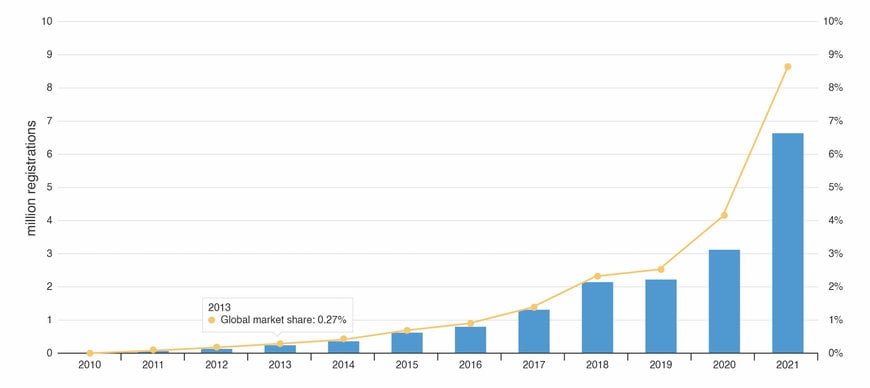
Number of electric car registrations and percent market share over time.
According to the ICCT, by 2030, medium- and heavy-duty vehicles are projected to increase energy consumption by 140,000 megawatt-hours per day. Much of that demand will be along the National Highway Freight Network (NHFN) for long-haul trucking and in states that have adopted California’s Advanced Clean Trucks rule. To help alleviate the potential stress on the electric grid, California, which has about a million EVs on the road, is looking at how to accelerate vehicle-to-grid (V2G) through legislation.
A two-way street
While there’s been a lot of talk about the potential of V2G charging, today’s charging infrastructure and EVs are typically set up to go one way: from the grid or another source to the vehicle. In a typical battery charging scenario, an AC-DC converter applies power factor correction (PFC) and converts the AC grid voltage into a high voltage DC output that supplies the input of an isolated DC-DC converter. The DC-DC converter provides galvanic isolation for safety and converts the fixed DC input voltage into a constant current (CC) or constant voltage (CV) output that charges the battery with the help of the battery management system (BMS).
Bi-directional charging is a two-way street. Rather than just drawing power from the grid, an EV can send it back. There are two general ways to get AC power back out of the battery.
- Separate inverter
- Bi-directional power conversion
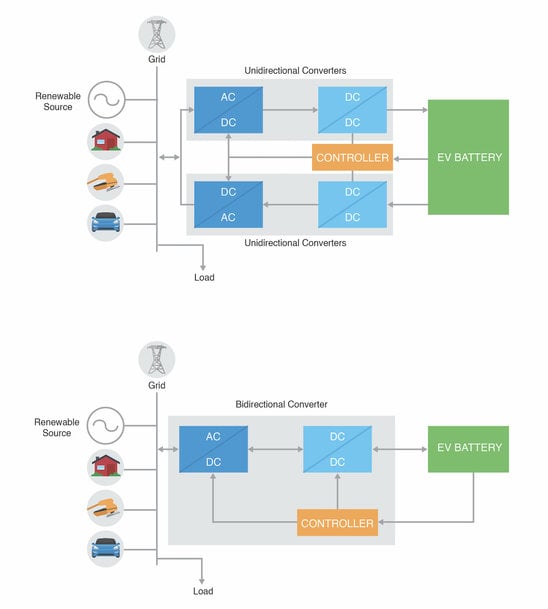
Bi-directional charger block diagram (top), Discrete inverter + charger block diagram
The most straightforward option is to use an inverter in parallel with the charger to convert the batteries DC voltage to an AC grid voltage, usually with the help of a DC-DC stage. This method takes up space, adds weight, and increases cost, but is simpler to design and control. To avoid the added space, weight, and cost a true bi-directional charger uses bi-directional switching topologies with complex digital controls to allow each power conversion stage to transfer power in either direction.
AC-DC Conversion and PFC
Not all power converter topologies are capable of bi-directional power transfer. One obvious reason is the use of bridge rectifiers in the AC-DC stage, which only pass current in one direction. These are often used for lower power chargers and followed by a boost converter with PFC, due to cost and simplicity. However, they are inefficient and don’t work well in parallel, which makes thermal management difficult at high power levels.
So-called bridgeless topologies remove the bridge rectifier to improve efficiency. These converters are more complex, as simple diodes are replaced with active switches, and some topologies are capable of bi-directional power flow. Perhaps the simplest example is the bridgeless totem-pole PFC topology which essentially replaces the bridge rectifier diodes with active bi-directional switches.

Boost PFC (left), Bridgeless totem-pole PFC (right)
In the AC-DC direction this topology resembles a boost converter and converts the AC input to a DC output, while shaping the input current to match the voltage for PFC. In the DC-AC direction the DC voltage is chopped up and filtered into an AC voltage. Other bi-directional topologies exist and are selected based on cost, power density, efficiency, and complexity. Efficiency is important to minimize waste and maximize battery utilization and life.
Bi-Directional DC-DC Conversion
The DC-DC stage is conceptually simpler as it’s performing DC-DC conversion no matter which way power is flowing. Like the AC-DC converter the rectifiers must be replaced with active switches to enable bi-directional power flow. You must also be able to actively control the switches on both input and output sides, which is complicated by the presence of isolation.
The common topology for this stage is known as the dual active bridge (DAB) converter. This converter contains an active full-bridge on each side of the isolation barrier. Resonant topologies are often used to minimize switching losses, reduce size, and maximize efficiency. The typical unidirectional LLC (inductor-inductor-capacitor) converter becomes a CLLC (capacitor-inductor-inductor-capacitor) DAB converter for bidirectional applications.
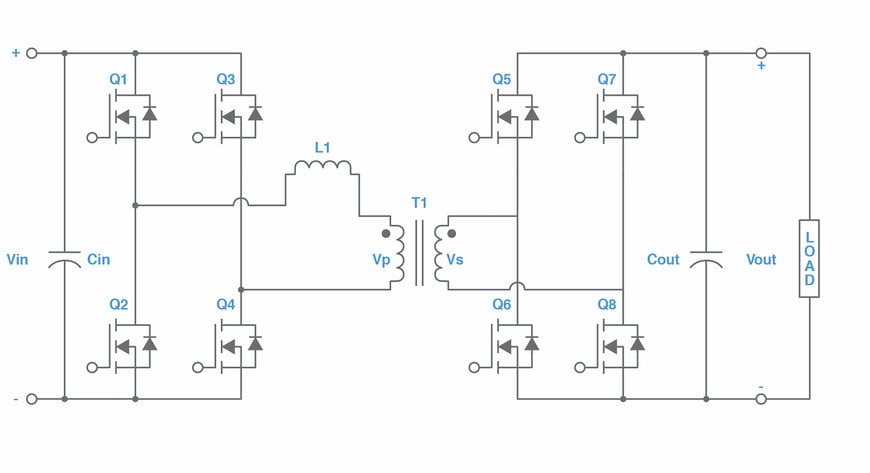
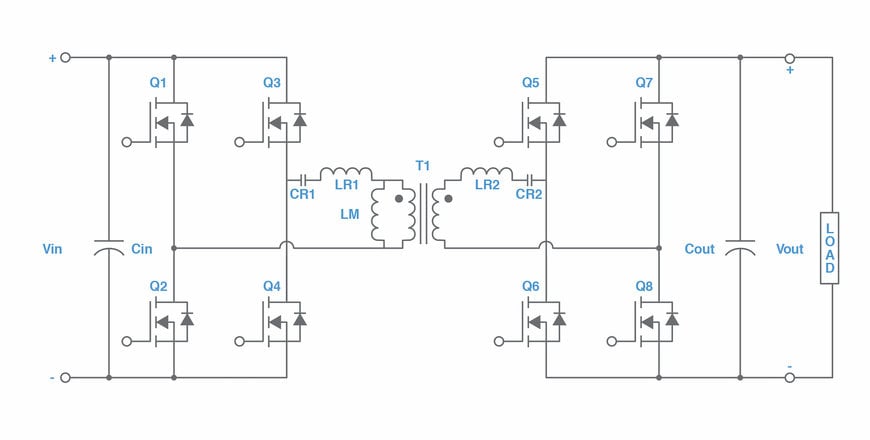
Dual active bridge converter (top), CLLC dual active bridge converter (bottom).
V2X: Vehicle to Everything
Regardless of whether the charger incorporates bi-direction topologies or a separate bulky inverter, there are many benefits to being able to export power from an EV battery. The benefits cover a range of applications, many of which have received a variation of the V2X naming. These include:
- V2G – Vehicle to grid
- V2B – Vehicle to building
- V2H – Vehicle to home
- V2E – Vehicle equipment
- V2V – Vehicle to vehicle
The most obvious benefit of bi-directional charging is that EVs could be used in a V2G model to power the electrical grid. By design, most electrical grids do not have substantial built-in storage. Generated power is consumed immediately or wasted, which leads to complex estimates of demand in order to supply enough energy without excess waste. When it comes to renewable energy generation, such as wind or solar, demand may exceed capacity during certain periods, such as a night for solar power.
By utilizing EV batteries for storage, electrical grids can maximize the power generated by renewables by storing the excess energy for use when output is below demand. Because the battery is closer to the load, it can help supply load transient current to help maintain grid stability. Batteries could essentially act as capacitors, supplying peak power needs locally, which can reduce stress on distribution lines and transformers and reduce voltage fluctuation.
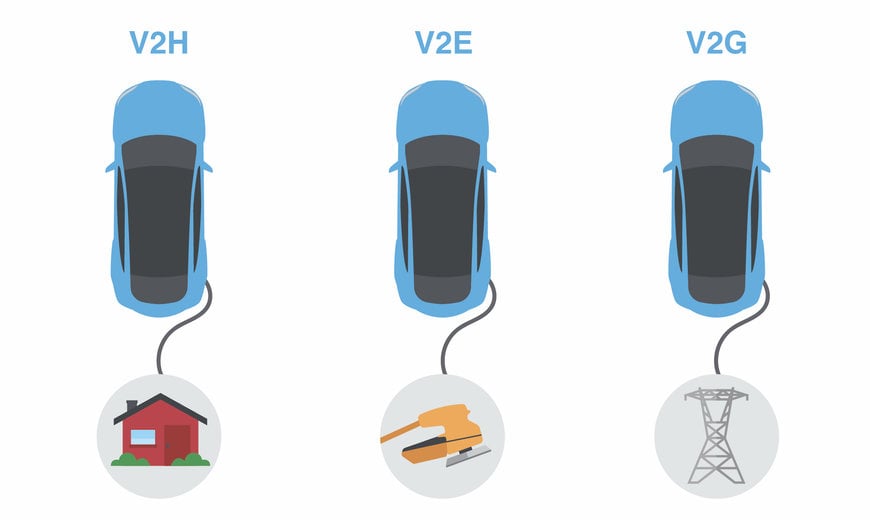
V2X Application Examples
Emergencies are another compelling case for EVs to supply power back to the grid. In the event of a power outage, city vehicles could keep essential buildings (V2B) and (V2E) equipment running, while a high-rise tower could leverage EVs connected to charging stations in its parking garage to power the building—essentially an alternative uninterruptible power supply (UPS). Even a single-family home could potentially rely on an EV to get them through a blackout through vehicle-to-home (V2H).
One V2B scenario that’s being tried out in the city of Boulder, Colorado is connecting a Nissan Leaf via a bi-directional charger to the North Boulder Recreation Center. The goal is to save energy costs by charging the Nissan Leaf battery at night and then discharging it at times of peak demand. This has the effect of reducing pressure on the electrical grid and saving electricity costs.
Urban use cases
But pulling power out of EVs to transfer it back to the grid or a single building is just the beginning. There are plenty of compelling and creative use cases for bi-directional charging. An EV that can transfer power bi-directionally essentially becomes a mobile charging unit. With more EVs on the road, getting a boost from jumper cables could be replaced by a vehicle-to-vehicle (V2V) transfer so one EV can boost another that’s stranded.
Beyond the obvious residential and consumer applications for bi-directional charging there are many use cases in a variety of industries and environments, including commercial fleets, construction, and agriculture. Not only could an EV charge another car, but it could also be used to charge other vehicles such as e-bikes and commercial fleets.
Bi-directional charging capabilities would enable a shipping and logistics firm with a fleet of trucks to use its EVs to meet its own energy needs by creating a self-sustaining ecosystem. By establishing its own microgrid or nanogrid systems, a business could become more energy independent. In combination with renewable energy systems such as solar panels, it would be possible for a business to become less dependent on the grid and make its buildings self-reliant.

Home Using EV to Store Excess Solar Energy.
Like V2G applications where EVs could send power back to the grid in the event of a blackout, businesses could use their vehicles as a UPS to maintain operations. They could also balance their own power demands more efficiently to save money on their energy bills. Vehicles can be charged during off-peak hours and then discharge back to the grid during peak hours.
A major distribution warehouse may have a many as a hundred vehicles leaving at 10:00 AM every day, but when they’re parked in the garage, they potentially have megawatt hours of energy that could be used rather paying for electricity from the grid at peak times, allowing for the ability to shift demand from the utility to cheaper times of day.
Rural use cases
Not all V2G or V2V scenarios need to take place in urban areas. Rural communities with farms can benefit from bi-directional charging. All-electric tractors have been available for several years now, and more recently, V2V charging tender trucks. Rather than the tractor being charged by a standalone charger in a fixed place, tractors and other farm vehicles can be charged in the field, much like a fuel truck that’s driven to where it’s needed rather than bringing the tractors back to a gas pump.
Equipment in the field could also benefit from bi-directional charging. Imagine running a construction site with a whole host of tools, specialized vehicles and equipment. Long cords spread across the site are a safety hazard. Battery-powered tools that could be charged by a medium-to-heavy EV as needed—the electric equivalent of a gas-powered generator—could be more efficient. That same truck could also charge other smaller vehicles on-site, such as excavators, bulldozers, and cranes.

Field equipment powered by bi-directional charging technology.
These remote work sites or agricultural areas might also be tapping into wind and solar panels to work in concert with their EV charging infrastructure. Because commercial vehicles in delivery fleets and heavy construction trucks have large batteries, especially relative to the typical consumer EV, there are hundreds of kilowatt hours of stored energy that could be redistributed for commercial and large-scale purposes.
Bel delivers bi-directional power solutions
Given all the benefits and use cases, there’s clearly a need for bidirectional power transfer capabilities in EV’s and EV supply equipment. Bel has developed a broad portfolio of EV power solutions that enable bi-directional power flow including inverters, chargers, and bi-directional combo units. These innovative products are suitable for a range of vehicles, from medium to heavy duty, on and off road, and can help maximize the utility of the battery.

Bel’s breadth of EV Solutions.
Bel’s bi-directional chargers are designed to address the many emerging use cases where there’s a compelling reason to draw energy from a vehicle to redirect it back to the grid, other vehicles, or equipment in the field, and ultimately make businesses more efficient and productive. Bel’s product and design team is also available to create custom solutions to fit a variety of needs and deployment use cases. Contact our Bel Power Solutions group to learn more about how to take advantage of bi-directional charging for your organization.
www.belfuse.com

